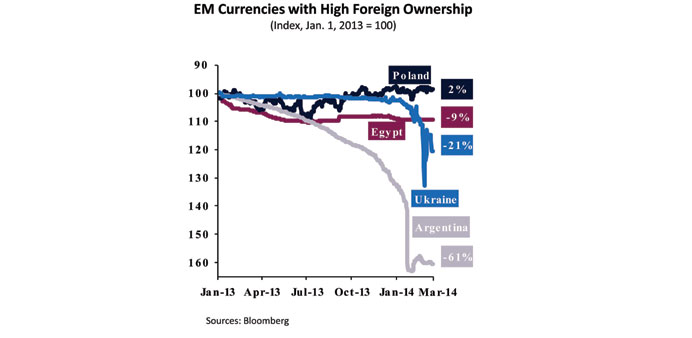The Qatar National Bank (QNB) Group has underscored the importance of foreign ownership of debts as an indicator of vulnerability to the crisis faced by emerging markets (EMs).
Citing a new study by the International Monetary Fund (IMF), the QNB Group noted that since the Federal Reserve chair Janet Yellen announced the gradual reduction of its asset-purchasing programme or quantitative easing (QE), EMs have witnessed large capital outflow and strong devaluation of currencies.
“Overall, the IMF study provides an interesting new insight into the ongoing development of the EM crisis associated with QE tapering. It suggests that both large current account deficits and high foreign ownership of government debt can be key indicators of an EM vulnerability to continued capital flight,” the QNB Group said.
It added that the IMF analysis sheds light on why some countries are particularly vulnerable, given that a large portion of their debt is in the hands of foreigners. The study underscores that a number of countries are particularly vulnerable, including Argentina, Egypt, Poland and Ukraine.
The study also estimates total government debt of 24 major EMs at $9.6tn at end of June 2013. Of this amount, government debt held by foreign institutions was around $1.4tn or 14.6%. Around 80% of this was held by foreign asset managers (large institutional investors, hedge funds, and sovereign wealth funds).
The study further estimates that more than half of EMs’ government debt or $800bn held by foreign institutions has flowed in since 2010.
Stronger inflows were most probably a consequence of near-zero interest rates across advanced economies, which made higher sovereign yields in EMs attractive. The inflows were also less selective across EMs following the global financial crisis.
The study suggests that this was because most EMs were relatively unscathed by the crisis, recovering quickly and their high growth perpetuated expectations for further currency appreciation.
This came to an abrupt end in May 2013 as the gradual reduction in QE raised the prospect of higher interest rates in advanced economies, thus reversing the capital flows into EMs.
This has revealed the vulnerabilities of EM markets to capital outflows, particularly those with large current account deficits and high foreign debt ownership. A number of EM currencies proved vulnerable to capital outflows in the second half of 2013.
Since then, investors have started to differentiate more with Argentina and Ukraine badly hit while Egypt and Poland have, so far, weathered the EM crisis better.
The IMF analysis examined a scenario in which foreign private investors maintain their exposure to EM sovereigns at the same level. It found that Egypt and Poland would require government funding of more than 3% of bank assets.
The IMF examined a second scenario in which private investors roll over only 50% of government debt holdings maturing in a year. In this case, Argentina and Ukraine would also become sensitive to foreign outflows.
The analysis has proved itself relevant in recent months with the currencies of Argentina, Ukraine and, to a lesser extent, Egypt all succumbing to vulnerabilities.
Argentina and Ukraine both have relatively high foreign ownership of government debt (30% and 46%, respectively) and have faced severe currency weakness. Meanwhile, Egypt has a lower level of foreign ownership (13%) and has not experienced such a severe depreciation.
The Argentinean economy has been blighted by burdensome debt, weak growth, and high inflation resulting in a steady weakening of the Argentine Peso for a number of years. This accelerated into a full-blown collapse in January 2014 as international reserves fell to unsustainable levels.
Political instability in Ukraine eroded confidence in its currency in early 2014. Russia’s military intervention in Crimea heightened tensions more recently and led to further capital outflows and a sharp weakening of the currency. This is likely to continue unless a political solution to the Crimea crisis is found.
In Egypt, low levels of foreign debt ownership mean that capital flight has been lower, making it easier for the authorities to support the currency. In addition, significant GCC grants in 2013 have helped the government to reduce its reliance on foreign investors buying its debt. This has helped maintain a relatively steady exchange rate of the Egyptian Pound during late 2013 and early 2014, notwithstanding major political developments.
Despite high foreign ownership of government debt in Poland (50%), the currency has performed well as the economy is growing strongly and overall government debt is falling. However, should the economic situation turns sour, foreign ownership provides an important indicator that the country would be vulnerable to capital outflows.



